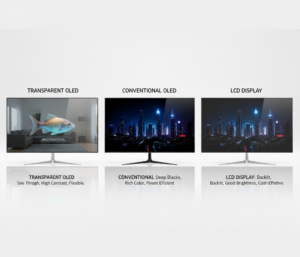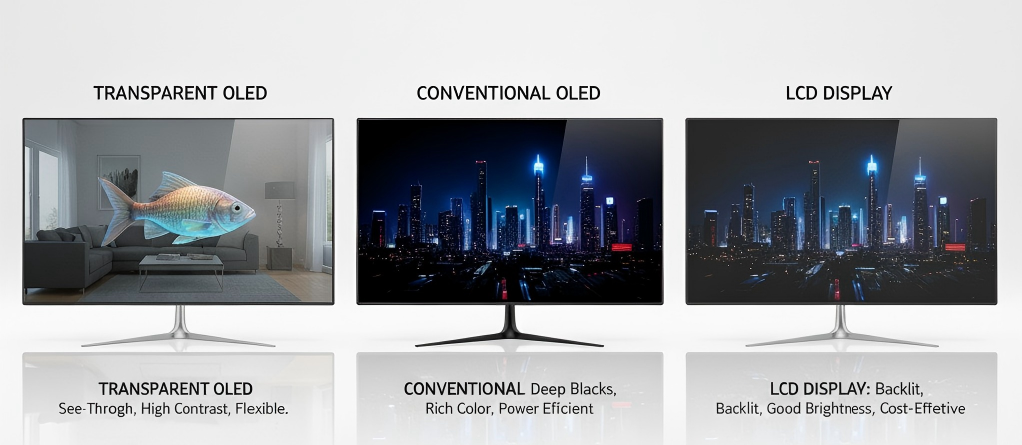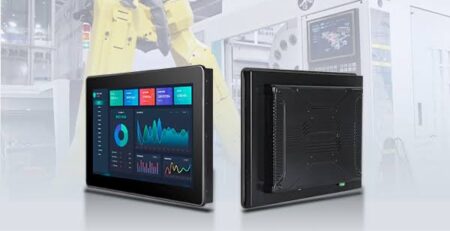The world of display technology stands at the dawn of a new era. While regular OLED and LCD compete for the title of ‘king of image quality,’ a more revolutionary technology—Transparent OLED—has shifted the competition to another level. It is no longer just about which has more vibrant colors or deeper blacks. It is fundamentally redefining the relationship between the ‘screen’ and ‘space’.
To understand their core differences, we must go beyond simple specs. We need to look at their physical foundations. This reveals a shift in technical paradigm—from ‘how to control light’ to ‘how to create and let light pass through’.

I. LCD – The Precise “Light Valve”
1. Core Paradigm: Light Modulation
2. Think of an LCD as a very precise shutter system. It does not create its own light. Instead, it relies on a backlight unit that is always on.
3. Liquid crystal molecules act like tiny shutter blades. An electric current twists them to control how much backlight passes through.
4. Fundamental limits come from its structure:
-
Impure Blacks: Its “black” is just the shutters trying to close fully. Some backlight still leaks through. This puts a physical limit on its contrast.
- Slower Response: The physical twisting of liquid crystals is a millisecond-level process. This can cause motion blur in fast-paced scenes.
- Viewing Angles: Light passes through complex optical films and liquid crystal layers. When you view from an angle, brightness and color can fade.
5. In essence, LCD is an excellent ‘light modulator.’ But its complex ‘sandwich’ structure also creates its performance ceiling.
II. Regular OLED – The Self-Illuminating “Microscopic Stars”
1. Core Paradigm: Self-Emissive
2. OLED technology made a fundamental leap. It removed the bulky backlight. Each pixel is a tiny, independent light bulb (an Organic Light-Emitting Diode). It turns on with electricity and turns off completely without it.
3. Self-emission brings key advantages:
-
Infinite Contrast: A switched-off pixel emits zero light. This creates pure, perfect black.
-
Instant Response: Light emission is a microsecond, electronic process. It eliminates motion blur.
-
Wide Viewing Angles: Each pixel is an independent point of light. Colors and brightness stay consistent from almost any angle.
4. However, regular OLED has a ‘secret.’ For maximum efficiency, its cathode usually uses a reflective, opaque metal. This makes it a perfect, but non-transparent, canvas.
III. Transparent OLED – The “Magic Window” to the Future
1. Core Paradigm: Transparent Self-Emissive
2. Transparent OLED is not just a variant of regular OLED. It is a complete architectural revolution. It keeps all the benefits of self-emissive pixels. But it also answers a more ultimate question: How can a screen disappear when turned off?
3. The fundamental difference lies in two key innovations:
- Material Revolution: From “Reflective” to “Transmissive”
-
Challenge: The opaque cathode in regular OLED was the main obstacle.
-
Solution: Use highly transparent cathode and anode materials. For better flexibility and durability, new materials like silver nanowire composites are replacing traditional, brittle ITO. This ensures high transparency (>40%), good conductivity, and reliability when bent.
- Structural Revolution: Aperture Ratio is Key
-
Challenge: The TFTs (Thin-Film Transistors) and capacitors that drive the pixels are traditionally opaque. They block background light, creating a ‘grid.’
-
Solution: Use transparent TFT materials and transparent capacitor designs. This turns the wasted circuit areas into see-through parts, greatly improving the ‘aperture ratio.’
4. Why is this so important? A high aperture ratio means:
-
Higher Transparency: Background objects appear clearer.
-
Longer Lifespan & Lower Power: At the same brightness, a larger effective light-emitting area means each pixel works with lower current density. This slows material aging and improves energy efficiency.
5. The core mission of Transparent OLED is to change from an ‘information terminal’ to a ‘spatial element.’ It seamlessly blends digital information with the physical environment.
IV. Summary: From Physical Mechanism to Strategic Role
| Dimension | LCD | Regular OLED | Transparent OLED |
|---|---|---|---|
| Physical Mechanism | Light Modulation | Self-Emissive | Transparent Self-Emissive |
| Core Structure | Backlight Unit + Liquid Crystal Layer | Organic Emissive Layer + Reflective Cathode | Organic Emissive Layer + Transparent Electrodes |
| Black Level | Dark Gray, Limited Contrast | Pure Black, Infinite Contrast | Transparent, No Traditional Black |
| Strategic Role | Cost-Effective Display Terminal | Premium Image Quality Display Terminal | Spatial Integration, Digital-Physical Overlay |
V. The Future is Here: Applications for Transparent OLED
The breakthrough of Transparent OLED opens up uses far beyond traditional screens:
-
Retail: Shop windows are clear glass by day. At night, they transform into dynamic billboards without hiding the products.
-
Automotive: Navigation data can be projected onto the windshield, enabling true AR-HUD.
-
Smart Home: Glass partitions or windows can become screens showing weather, news, or video calls.
-
Museums & Exhibitions: Display information directly on transparent display case glass, enhancing the interactive experience.
The difference between LCD, regular OLED, and Transparent OLED is much more than just ‘transparency.’ It is the history of a technological evolution. We moved from passive light modulation to active self-emission, and now to transparent emission that blends with the environment.
Transparent OLED faces serious challenges. These include material cost, lifespan, and visibility in bright ambient light. But the direction it represents—breaking the boundary between screen and reality—is undoubtedly the future of display technology.
Next time you see a video playing on a clear sheet of glass, you will see more than just brilliant images. You will be looking through a ‘magic window’ to the future.
We hope you found these touchscreen or panel PC fundamentals informative. Goldenmargins offers a broad selection of Industrial Touchscreen Monitors and Touch Panel PCs in various sizes and configurations, including medical touch screens, sunlight-readable touch screens, open-frame touch screens, and waterproof touch panels, as well as other unique touch screen or panel PC designs. You can learn more about our services here or by calling us at +86 755 23191996 or sales@goldenmargins.com.





